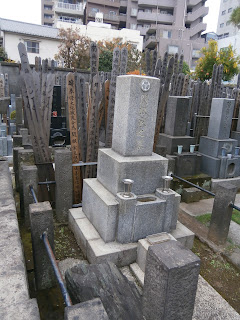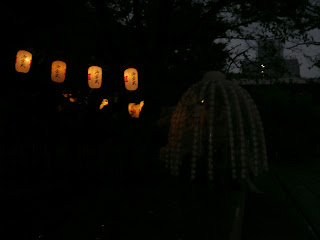In Bunkyō-ku 文京区 around Hakusan station 白山駅 there is a seamlessly endless number of temples. Along the route I took statues of Jizō-bisatsu 地蔵菩薩 were particularly numerous.
Jizō statue for
the mizuko (miscarried and aborted
infants) with ita-tōba 板塔婆 (“plank stūpa”). On each of these wooden grave tablets Jizō is invoked,
followed by the name of a family that lost a mizuko and the time of issuing e.g. O-bon お盆 (or urabon 盂蘭盆), Segakie 1 spring equinox or autumn equinox.Note how the Buddhist Jizō statues stand peacefully alongside the Shintoist (probably for the deity Inari 稲荷) shrine.
Kannon-bosatsu 観音菩薩
Some typical
Japanese graves. The pillar in the middle usually carries the family name and
the family crest. To the left and the right, you can see metal vases which are
attached to the grave itself for flower offerings, in the middle a basin for
water and a metal grid for burning incense underneath. It is common for
Japanese graves to contain the ashes of more than one person of the same
family.
Boke-Jizō ぼけ地蔵. Judging by the
name, this statue is most likely prayed to by elderly people who are afraid to
grow senile.
Another typical
Japanese family grave at Eishō-in 榮松院 (a temple belonging to the Pure Land sect). Behind the grave you can see
the ita-tōba I mentioned earlier.
This time Amida 阿弥陀 is invoked on top (“Namu Amida-butsu” or a Siddhaṃ
character symbolising him) as the graveyard belongs to the Pure Land school.
O-Mitsu-Jizō
お美津地蔵. Apparently, this Jizō statue
was enshrined by parents who lost a child at sea.
A stūpa
with the inscription “三界萬霊”, literally “ten thousand spirits of the three worlds”,
actually meaning “all the souls of the three realms of existence (past, present
and future)”.
The Komagome
Dai-Kannon 駒込大観音, an enormous statue of the Eleven-headed Kannon in a
rather modern looking building.
Concrete
Thousand-armed Kannon (statues of this manifestation of Kannon rarely actually
have a thousand arms, but with its mere twenty-four arms this statue looks more
modest than usual).
A common view
on Japanese graveyards: a Kannon statue and six aligned Jizō statues, one for
each of the six realms (rokudō 六道).
A very small
Shintoist shrine called Akiba-jinja 秋葉神社 between two residences.
Tenei-ji 天榮寺 (Pure Land Sect)
Tokugenzen-in 徳源禅院 (Rinzai 臨済 sect of Zen). Note the garden which gives away the fact that this is a Zen temple. On the last picture there is a sign that indicates there is a tea ceremony going on.
Jōtoku-ji 常徳寺(Pure Land sect)
It is
somewhat hard to see, but this picture shows an Amida triad (Amida-sanzon 阿弥陀三尊) which consists of the three beings that
are said to come down to earth to welcome followers of Amida at the moment of
death (来迎 raigō): the Buddha Amida himself and the two
bodhisattva’s Seishi 勢至 en Kannon.
Notes:
1 For more
information on Segakie, please refer to my blog entry from July 2012 titled “Segakie
in Gokoku-ji”.
Further reading
on the bodhisattva Jizō and mizuko:
LaFleur,
William R. (1992) Liquid Life: Abortion and Buddhism in Japan. Princeton:
Princeton University Press.


























